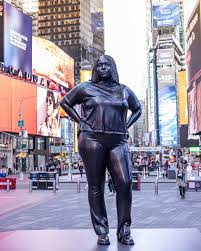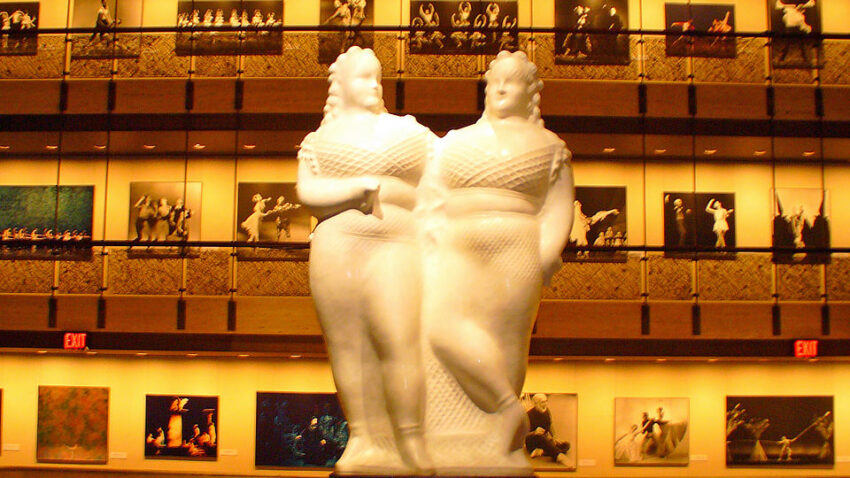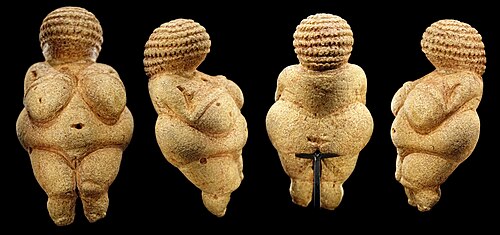Art for non-art’s sake: the Times Square monument to our age
A recent development in the world of art is the installation of a statue in Times Square. While the virtue-signaling have been busy pulling down heroic statues of white men, they are erecting this sort of thing in their stead:
New York City’s Times Square installed a statue of a 12-foot-tall Black woman in casual clothing that its creator hopes will encourage people to reflect on “greater cultural diversity.”
New York-based Times Square Arts recently put up the new statue display, titled “Grounded in the Stars,” by artist Thomas J Price, along with his “Man Series” animated billboards, both of which are temporary, but causing a stir online.
The Times Square website states, “Price’s multi-channel presentation on the screens and sculptural installation on the plaza below forms a two-part takeover in Times Square that foregrounds the intrinsic value of the individual and amplifies traditionally marginalized bodies on a monumental scale.”
Note the style of the writing. It’s a very typical Newspeak that originated in academic circles and functions as a sort of “I’m highly educated and oh-so-virtuous” tell.
The statue is neither attractive nor heroic, which is the point. It happens to be of a black woman or “woman of color” – another point. But if the race of the person depicted had been white, it certainly would not have been any more attractive. Is this the current urban Everywoman? I suppose. Her gaze is either blank or slightly defiant, but she looks like anyone you could see walking on the street. The statue’s only raison d’etre seems to be its anti-heroic and woke nature – that, and to conjure up controversy.

It reminds me somewhat of a trend I’ve noticed in advertisements and even some store mannequins that feature models who are not the least bit remarkable and only of very ordinary and average (or less than average) attractiveness. The only thing different about this woman is that she’s not in a store advertising anything; she’s supposed to be purely art plus politics.
By “traditionally marginalized bodies,” the author of that deathless descriptive prose I quoted can’t possibly mean “women who are a bit heavy.” There’s a lengthy art tradition for that, and even a more recent one. As a native New Yorker, I immediately thought of the Nadelman-inspired sculptures in the New York State Theater at Lincoln Center. I’ve always liked them, although I wasn’t sure why. Here’s one:

These women are also of the overweight variety. They’re white because the stone is white, but to me at least they seem beyond race and time. They’re supposed to be circus performers, but they certainly don’t look like any circus performers I’ve ever seen. There’s something monumental about them, something that isn’t political.
Speaking of old traditions, the image of the overweight ( that is, fat) woman has enormous antiquity. In fact, such sculptures are among the oldest art we have. I bring you as an example, the Venus of Willendorf, thought to be about 30K years old. The sculpture is only about four inches tall:

Then of course the overweight woman has a prominent place in painting of yesteryear from the Renaissance to Renoir and beyond, almost a cliched place. But none of these images have anything like the aura of the Times Square sculpture, which is anti-art or perhaps art as pure politics. As such, it’s emblematic of our times.

Art in service to ugliness was formerly known as comedy.
Ha!
That’s not funny.
I find referring to people as ‘bodies’ to be quite repulsive.
David Foster:
Agreed, and it’s very common among the woke.
That ancient fat woman was probably a bow to her fertility. The one in Times Square isn’t.
I was in Richmond a few years ago, following the Charlottesville controversy, when I heard a young woman say how nice it would be to get all those old statues out of the road and replace them with modern art. I don’t know what horrors have been erected since.
A monument to heart disease and diabetes? What’s not to like? I’m defiantly oppressed.
Was it TN Coates who first popularized the phrase “black bodies” around the time of Obummer’s second term?
Blacks used to be all about soul, a much more uplifting concept than the mere material of the body.
I have to admit that I like the sculpture in question, but only a little bit. I don’t think it’s nearly good enough to justify its size or location. It should be reduced to a foot or two high, then moved to an out of the way place, in a regional museum. It’d be a minor curiosity that might prompt a second look, before moving on. In my mind anyway, that kind of resetting would drain the piece of much of its tiresome politics.
Was it TN Coates who first popularized the phrase “black bodies” around the time of Obummer’s second term?
Marisa:
That’s where I first noticed that use of “bodies.”
It’s from the book, “Between the World and Me” — one of the worst I know. Poorly written, poorly considered, and shameful racist propaganda.
Naturally it won the 2015 National Book Award for Nonfiction.
Well at least the sculpture wasn’t a giant turd.
I checked the web for a famous public turd sculpture I once read of. I found several. It is, let us say, a common motif in modern sculpture.
Perhaps the reader thinks I’m joking.
__________________________
Public art is always subject to debate, and in San Diego, the preference tends to run on the less-than-sophisticated side. Statues of dolphins and fishermen will barely cause a ripple, but anything remotely abstract will elicit cries of outrage.
There is one sculpture in particular that caused befuddlement, more than outrage, along with a high-level of embarrassed chuckles. Representing a large bowel movement, hospital staff and patients of the Scripps Green Hospital referred to the sculpture piece as the “Scripps Turd” which remains its reputation to this day.
–“The Scripps Turd Sculpture in San Diego”
https://www.tripsavvy.com/the-okeanos-sculpture-scripps-green-hospital-2937428
__________________________
This sculptor is not some rando street artist, throwing bombs. He attended Oxford for three years. He has won a Guggenheim and a Lifetime Achievement Award.
Given that artists, especially sculptors, usually think about what they are doing, it’s hard for me not to consider such sculptures in part as the artist’s comment on the public.
Sadly, I still haven’t found the turd sculpture I was looking for.
That new statue looks to me like Letitia James. Just saying.
The overweight is yet another victim group that must be championed.
We have a family that are close friends. Their youngest daughter is very overweight, by at least a hundred pounds. She applied to a relative prestigious college in Virginia where my wife is an alumni. My wife said there’s no way she gets in with a high school GPA at the low C level and 20% SAT. I told my wife just watch as she’s now one of the victim groups. Sure enough the girl gets in. She lasted a year and then went home to go to the local community college.
This comment also could go in Neo’s post above on the lack of meritocracy.
The statue of the overweight woman of color looks like every overweight, middle-aged woman of color about to throw a public confrontational tantrum with a minimum wage cashier or fast-food service worker. The kind of woman who sets off the kind of public brawl recorded on a bystanders’ cellphone that makes a social media splash and not in a good way.
”The overweight is yet another victim group that must be championed.”
Not all of the overweight, just overweight women. Overweight men are held in more contempt and subject to more ridicule than ever.
Sgt. Mom: that was exactly my reaction. I happened to have seen just such a video within the previous day or so of seeing the statue, and the connection made itself pretty insistently. I wonder how many people reacted that way. If many, the statue may have had the opposite of its intended effect.
“That new statue looks to me like Letitia James.” I agree, or Fani Willis.
Or, as I saw on another site, “DMV employee taking her seventh break.” 🙂